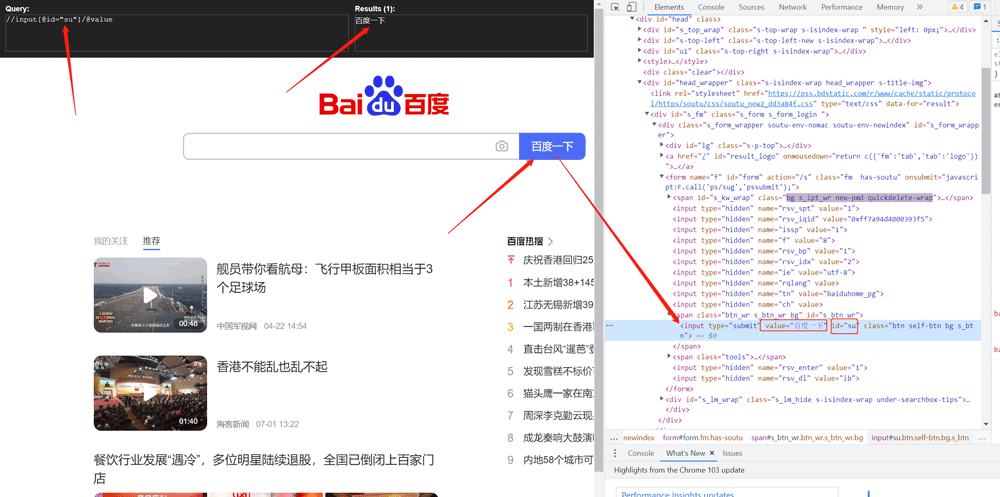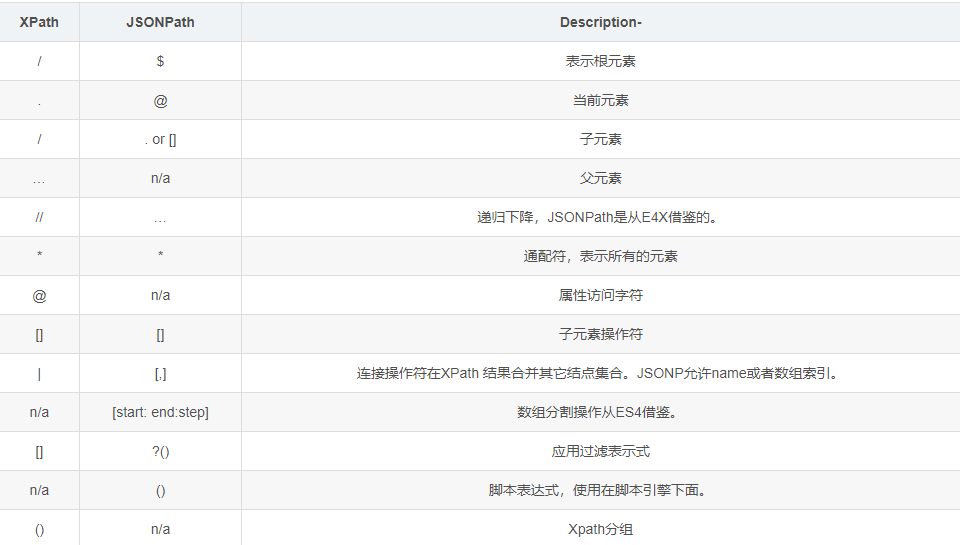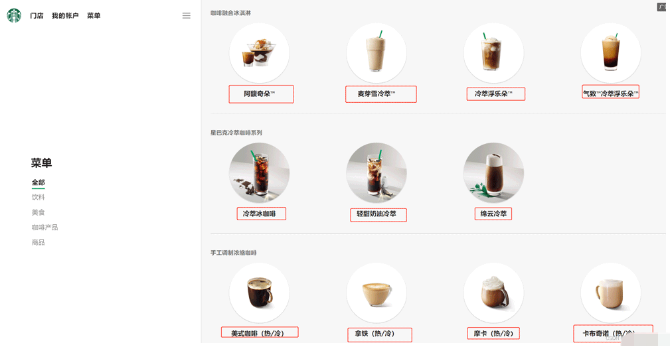您好,登錄后才能下訂單哦!
您好,登錄后才能下訂單哦!
本篇內容介紹了“Python xpath,JsonPath,bs4怎么使用”的有關知識,在實際案例的操作過程中,不少人都會遇到這樣的困境,接下來就讓小編帶領大家學習一下如何處理這些情況吧!希望大家仔細閱讀,能夠學有所成!
google提前安裝xpath插件,按ctrl + shift + x 出現小黑框
安裝lxml庫 pip install lxml ‐i https://pypi.douban.com/simple
導入lxml.etreefrom lxml import etree
etree.parse() 解析本地文件html_tree = etree.parse('XX.html')
etree.HTML() 服務器響應文件html_tree = etree.HTML(response.read().decode('utf‐8')
.html_tree.xpath(xpath路徑)
1.路徑查詢
查找所有子孫節點,不考慮層級關系
找直接子節點
2.謂詞查詢
//div[@id] //div[@id="maincontent"]
3.屬性查詢
//@class
4.模糊查詢
//div[contains(@id, "he")] //div[starts‐with(@id, "he")]
5.內容查詢
//div/h2/text()
6.邏輯運算
//div[@id="head" and @class="s_down"] //title | //price
xpath.html
<!DOCTYPE html> <html lang="en"> <head> <meta charset="UTF-8"/> <title>Title</title> </head> <body> <ul> <li id="l1" class="class1">北京</li> <li id="l2" class="class2">上海</li> <li id="d1">廣州</li> <li>深圳</li> </ul> </body> </html>
from lxml import etree
# xpath解析
# 本地文件: etree.parse
# 服務器相應的數據 response.read().decode('utf-8') etree.HTML()
tree = etree.parse('xpath.html')
# 查找url下邊的li
li_list = tree.xpath('//body/ul/li')
print(len(li_list)) # 4
# 獲取標簽中的內容
li_list = tree.xpath('//body/ul/li/text()')
print(li_list) # ['北京', '上海', '廣州', '深圳']
# 獲取帶id屬性的li
li_list = tree.xpath('//ul/li[@id]')
print(len(li_list)) # 3
# 獲取id為l1的標簽內容
li_list = tree.xpath('//ul/li[@id="l1"]/text()')
print(li_list) # ['北京']
# 獲取id為l1的class屬性值
c1 = tree.xpath('//ul/li[@id="l1"]/@class')
print(c1) # ['class1']
# 獲取id中包含l的標簽
li_list = tree.xpath('//ul/li[contains(@id, "l")]/text()')
print(li_list) # ['北京', '上海']
# 獲取id以d開頭的標簽
li_list = tree.xpath('//ul/li[starts-with(@id,"d")]/text()')
print(li_list) # ['廣州']
# 獲取id為l2并且class為class2的標簽
li_list = tree.xpath('//ul/li[@id="l2" and @class="class2"]/text()')
print(li_list) # ['上海']
# 獲取id為l2或id為d1的標簽
li_list = tree.xpath('//ul/li[@id="l2"]/text() | //ul/li[@id="d1"]/text()')
print(li_list) # ['上海', '廣州']import urllib.request
from lxml import etree
url = 'http://www.baidu.com'
headers = {
'User-Agent': 'Mozilla/5.0 (Windows NT 10.0; Win64; x64) AppleWebKit/537.36 (KHTML, like Gecko) Chrome/103.0.0.0 Safari/537.36'
}
request = urllib.request.Request(url=url, headers=headers)
response = urllib.request.urlopen(request)
content = response.read().decode('utf-8')
tree = etree.HTML(content)
value = tree.xpath('//input[@id="su"]/@value')
print(value)
1.5 爬取站長素材的圖片
# 需求 下載的前十頁的圖片
# https://sc.chinaz.com/tupian/qinglvtupian.html 1
# https://sc.chinaz.com/tupian/qinglvtupian_page.html
import urllib.request
from lxml import etree
def create_request(page):
if (page == 1):
url = 'https://sc.chinaz.com/tupian/qinglvtupian.html'
else:
url = 'https://sc.chinaz.com/tupian/qinglvtupian_' + str(page) + '.html'
headers = {
'User-Agent': 'Mozilla/5.0 (Windows NT 10.0; Win64; x64) AppleWebKit/537.36 (KHTML, like Gecko) Chrome/92.0.4515.159 Safari/537.36',
}
request = urllib.request.Request(url=url, headers=headers)
return request
def get_content(request):
response = urllib.request.urlopen(request)
content = response.read().decode('utf-8')
return content
def down_load(content):
# 下載圖片
# urllib.request.urlretrieve('圖片地址','文件的名字')
tree = etree.HTML(content)
name_list = tree.xpath('//div[@id="container"]//a/img/@alt')
# 一般設計圖片的網站都會進行懶加載
src_list = tree.xpath('//div[@id="container"]//a/img/@src2')
print(src_list)
for i in range(len(name_list)):
name = name_list[i]
src = src_list[i]
url = 'https:' + src
urllib.request.urlretrieve(url=url, filename='./loveImg/' + name + '.jpg')
if __name__ == '__main__':
start_page = int(input('請輸入起始頁碼'))
end_page = int(input('請輸入結束頁碼'))
for page in range(start_page, end_page + 1):
# (1) 請求對象的定制
request = create_request(page)
# (2)獲取網頁的源碼
content = get_content(request)
# (3)下載
down_load(content)pip install jsonpath
obj = json.load(open('json文件', 'r', encoding='utf‐8'))
ret = jsonpath.jsonpath(obj, 'jsonpath語法')JSONPath語法元素和對應XPath元素的對比:

示例:
jsonpath.json
{ "store": {
"book": [
{ "category": "修真",
"author": "六道",
"title": "壞蛋是怎樣練成的",
"price": 8.95
},
{ "category": "修真",
"author": "天蠶土豆",
"title": "斗破蒼穹",
"price": 12.99
},
{ "category": "修真",
"author": "唐家三少",
"title": "斗羅大陸",
"isbn": "0-553-21311-3",
"price": 8.99
},
{ "category": "修真",
"author": "南派三叔",
"title": "星辰變",
"isbn": "0-395-19395-8",
"price": 22.99
}
],
"bicycle": {
"author": "老馬",
"color": "黑色",
"price": 19.95
}
}
}import json
import jsonpath
obj = json.load(open('jsonpath.json', 'r', encoding='utf-8'))
# 書店所有書的作者
author_list = jsonpath.jsonpath(obj, '$.store.book[*].author')
print(author_list) # ['六道', '天蠶土豆', '唐家三少', '南派三叔']
# 所有的作者
author_list = jsonpath.jsonpath(obj, '$..author')
print(author_list) # ['六道', '天蠶土豆', '唐家三少', '南派三叔', '老馬']
# store下面的所有的元素
tag_list = jsonpath.jsonpath(obj, '$.store.*')
print(
tag_list) # [[{'category': '修真', 'author': '六道', 'title': '壞蛋是怎樣練成的', 'price': 8.95}, {'category': '修真', 'author': '天蠶土豆', 'title': '斗破蒼穹', 'price': 12.99}, {'category': '修真', 'author': '唐家三少', 'title': '斗羅大陸', 'isbn': '0-553-21311-3', 'price': 8.99}, {'category': '修真', 'author': '南派三叔', 'title': '星辰變', 'isbn': '0-395-19395-8', 'price': 22.99}], {'author': '老馬', 'color': '黑色', 'price': 19.95}]
# store里面所有東西的price
price_list = jsonpath.jsonpath(obj, '$.store..price')
print(price_list) # [8.95, 12.99, 8.99, 22.99, 19.95]
# 第三個書
book = jsonpath.jsonpath(obj, '$..book[2]')
print(book) # [{'category': '修真', 'author': '唐家三少', 'title': '斗羅大陸', 'isbn': '0-553-21311-3', 'price': 8.99}]
# 最后一本書
book = jsonpath.jsonpath(obj, '$..book[(@.length-1)]')
print(book) # [{'category': '修真', 'author': '南派三叔', 'title': '星辰變', 'isbn': '0-395-19395-8', 'price': 22.99}]
# 前面的兩本書
book_list = jsonpath.jsonpath(obj, '$..book[0,1]')
# book_list = jsonpath.jsonpath(obj,'$..book[:2]')
print(
book_list) # [{'category': '修真', 'author': '六道', 'title': '壞蛋是怎樣練成的', 'price': 8.95}, {'category': '修真', 'author': '天蠶土豆', 'title': '斗破蒼穹', 'price': 12.99}]
# 條件過濾需要在()的前面添加一個?
# 過濾出所有的包含isbn的書。
book_list = jsonpath.jsonpath(obj, '$..book[?(@.isbn)]')
print(
book_list) # [{'category': '修真', 'author': '唐家三少', 'title': '斗羅大陸', 'isbn': '0-553-21311-3', 'price': 8.99}, {'category': '修真', 'author': '南派三叔', 'title': '星辰變', 'isbn': '0-395-19395-8', 'price': 22.99}]
# 哪本書超過了10塊錢
book_list = jsonpath.jsonpath(obj, '$..book[?(@.price>10)]')
print(
book_list) # [{'category': '修真', 'author': '天蠶土豆', 'title': '斗破蒼穹', 'price': 12.99}, {'category': '修真', 'author': '南派三叔', 'title': '星辰變', 'isbn': '0-395-19395-8', 'price': 22.99}]1.安裝
pip install bs4
2.導入
from bs4 import BeautifulSoup
3.創建對象
服務器響應的文件生成對象 soup = BeautifulSoup(response.read().decode(), 'lxml')
本地文件生成對象 soup = BeautifulSoup(open('1.html'), 'lxml')
注意:默認打開文件的編碼格式gbk所以需要指定打開編碼格式utf-8
1.根據標簽名查找節點
soup.a 【注】只能找到第一個a
soup.a.name
soup.a.attrs
2.函數
(1).find(返回一個對象)
find('a'):只找到第一個a標簽
find('a', title='名字')
find('a', class_='名字')
(2).find_all(返回一個列表)
find_all('a') 查找到所有的a
find_all(['a', 'span']) 返回所有的a和span
find_all('a', limit=2) 只找前兩個a
(3).select(根據選擇器得到節點對象)【推薦】
1.element
eg:p
2..class
eg:.firstname
3.#id
eg:#firstname
4.屬性選擇器
[attribute]
eg:li = soup.select('li[class]')
[attribute=value]
eg:li = soup.select('li[class="hengheng1"]')
5.層級選擇器
element element
div p
element>element
div>p
element,element
div,p
eg:soup = soup.select('a,span')1.根據標簽名查找節點
soup.a 【注】只能找到第一個a
soup.a.name
soup.a.attrs
2.函數
(1).find(返回一個對象)
find('a'):只找到第一個a標簽
find('a', title='名字')
find('a', class_='名字')
(2).find_all(返回一個列表)
find_all('a') 查找到所有的a
find_all(['a', 'span']) 返回所有的a和span
find_all('a', limit=2) 只找前兩個a
(3).select(根據選擇器得到節點對象)【推薦】
1.element
eg:p
2..class
eg:.firstname
3.#id
eg:#firstname
4.屬性選擇器
[attribute]
eg:li = soup.select('li[class]')
[attribute=value]
eg:li = soup.select('li[class="hengheng1"]')
5.層級選擇器
element element
div p
element>element
div>p
element,element
div,p
eg:soup = soup.select('a,span')(1).獲取節點內容:適用于標簽中嵌套標簽的結構
obj.string
obj.get_text()【推薦】
(2).節點的屬性
tag.name 獲取標簽名
eg:tag = find('li)
print(tag.name)
tag.attrs將屬性值作為一個字典返回
(3).獲取節點屬性
obj.attrs.get('title')【常用】
obj.get('title')
obj['title'](1).獲取節點內容:適用于標簽中嵌套標簽的結構
obj.string
obj.get_text()【推薦】
(2).節點的屬性
tag.name 獲取標簽名
eg:tag = find('li)
print(tag.name)
tag.attrs將屬性值作為一個字典返回
(3).獲取節點屬性
obj.attrs.get('title')【常用】
obj.get('title')
obj['title']bs4.html
<!DOCTYPE html> <html lang="en"> <head> <meta charset="UTF-8"> <title>Title</title> </head> <body> <div> <ul> <li id="l1">張三</li> <li id="l2">李四</li> <li>王五</li> <a href="" id=" rel="external nofollow" rel="external nofollow" rel="external nofollow" rel="external nofollow" rel="external nofollow" rel="external nofollow" rel="external nofollow" rel="external nofollow" rel="external nofollow" " class="a1">google</a> <span>嘿嘿嘿</span> </ul> </div> <a href="" title=" rel="external nofollow" rel="external nofollow" rel="external nofollow" rel="external nofollow" rel="external nofollow" rel="external nofollow" a2">百度</a> <div id="d1"> <span> 哈哈哈 </span> </div> <p id="p1" class="p1">呵呵呵</p> </body> </html>
from bs4 import BeautifulSoup
# 通過解析本地文件 來將bs4的基礎語法進行講解
# 默認打開的文件的編碼格式是gbk 所以在打開文件的時候需要指定編碼
soup = BeautifulSoup(open('bs4.html', encoding='utf-8'), 'lxml')
# 根據標簽名查找節點
# 找到的是第一個符合條件的數據
print(soup.a) # <a class="a1" href="" id=" rel="external nofollow" rel="external nofollow" rel="external nofollow" rel="external nofollow" rel="external nofollow" rel="external nofollow" rel="external nofollow" rel="external nofollow" rel="external nofollow" ">google</a>
# 獲取標簽的屬性和屬性值
print(soup.a.attrs) # {'href': '', 'id': '', 'class': ['a1']}
# bs4的一些函數
# (1)find
# 返回的是第一個符合條件的數據
print(soup.find('a')) # <a class="a1" href="" id=" rel="external nofollow" rel="external nofollow" rel="external nofollow" rel="external nofollow" rel="external nofollow" rel="external nofollow" rel="external nofollow" rel="external nofollow" rel="external nofollow" ">google</a>
# 根據title的值來找到對應的標簽對象
print(soup.find('a', title="a2")) # <a href="" title=" rel="external nofollow" rel="external nofollow" rel="external nofollow" rel="external nofollow" rel="external nofollow" rel="external nofollow" a2">百度</a>
# 根據class的值來找到對應的標簽對象 注意的是class需要添加下劃線
print(soup.find('a', class_="a1")) # <a class="a1" href="" id=" rel="external nofollow" rel="external nofollow" rel="external nofollow" rel="external nofollow" rel="external nofollow" rel="external nofollow" rel="external nofollow" rel="external nofollow" rel="external nofollow" ">google</a>
# (2)find_all 返回的是一個列表 并且返回了所有的a標簽
print(soup.find_all('a')) # [<a class="a1" href="" id=" rel="external nofollow" rel="external nofollow" rel="external nofollow" rel="external nofollow" rel="external nofollow" rel="external nofollow" rel="external nofollow" rel="external nofollow" rel="external nofollow" ">google</a>, <a href="" title=" rel="external nofollow" rel="external nofollow" rel="external nofollow" rel="external nofollow" rel="external nofollow" rel="external nofollow" a2">百度</a>]
# 如果想獲取的是多個標簽的數據 那么需要在find_all的參數中添加的是列表的數據
print(soup.find_all(['a','span'])) # [<a class="a1" href="" id=" rel="external nofollow" rel="external nofollow" rel="external nofollow" rel="external nofollow" rel="external nofollow" rel="external nofollow" rel="external nofollow" rel="external nofollow" rel="external nofollow" ">google</a>, <span>嘿嘿嘿</span>, <a href="" title=" rel="external nofollow" rel="external nofollow" rel="external nofollow" rel="external nofollow" rel="external nofollow" rel="external nofollow" a2">百</a><spa哈</span>]
# limit的作用是查找前幾個數據
print(soup.find_all('li', limit=2)) # [<li id="l1">張三</li>, <li id="l2">李四</li>]
# (3)select(推薦)
# select方法返回的是一個列表 并且會返回多個數據
print(soup.select('a')) # [<a class="a1" href="" id=" rel="external nofollow" rel="external nofollow" rel="external nofollow" rel="external nofollow" rel="external nofollow" rel="external nofollow" rel="external nofollow" rel="external nofollow" rel="external nofollow" ">google</a>, <a href="" title=" rel="external nofollow" rel="external nofollow" rel="external nofollow" rel="external nofollow" rel="external nofollow" rel="external nofollow" a2">百度</a>]
# 可以通過.代表class 我們把這種操作叫做類選擇器
print(soup.select('.a1')) # [<a class="a1" href="" id=" rel="external nofollow" rel="external nofollow" rel="external nofollow" rel="external nofollow" rel="external nofollow" rel="external nofollow" rel="external nofollow" rel="external nofollow" rel="external nofollow" ">google</a>]
print(soup.select('#l1')) # [<li id="l1">張三</li>]
# 屬性選擇器---通過屬性來尋找對應的標簽
# 查找到li標簽中有id的標簽
print(soup.select('li[id]')) # [<li id="l1">張三</li>, <li id="l2">李四</li>]
# 查找到li標簽中id為l2的標簽
print(soup.select('li[id="l2"]')) # [<li id="l2">李四</li>]
# 層級選擇器
# 后代選擇器
# 找到的是div下面的li
print(soup.select('div li')) # [<li id="l1">張三</li>, <li id="l2">李四</li>, <li>王五</li>]
# 子代選擇器
# 某標簽的第一級子標簽
# 注意:很多的計算機編程語言中 如果不加空格不會輸出內容 但是在bs4中 不會報錯 會顯示內容
print(soup.select('div > ul > li')) # [<li id="l1">張三</li>, <li id="l2">李四</li>, <li>王五</li>]
# 找到a標簽和li標簽的所有的對象
print(soup.select(
'a,li')) # [<li id="l1">張三</li>, <li id="l2">李四</li>, <li>王五</li>, <a class="a1" href="" id=" rel="external nofollow" rel="external nofollow" rel="external nofollow" rel="external nofollow" rel="external nofollow" rel="external nofollow" rel="external nofollow" rel="external nofollow" rel="external nofollow" ">google</a>, <a href="" title=" rel="external nofollow" rel="external nofollow" rel="external nofollow" rel="external nofollow" rel="external nofollow" rel="external nofollow" a2">百度</a>]
# 節點信息
# 獲取節點內容
obj = soup.select('#d1')[0]
# 如果標簽對象中 只有內容 那么string和get_text()都可以使用
# 如果標簽對象中 除了內容還有標簽 那么string就獲取不到數據 而get_text()是可以獲取數據
# 我們一般情況下 推薦使用get_text()
print(obj.string) # None
print(obj.get_text()) # 哈哈哈
# 節點的屬性
obj = soup.select('#p1')[0]
# name是標簽的名字
print(obj.name) # p
# 將屬性值左右一個字典返回
print(obj.attrs) # {'id': 'p1', 'class': ['p1']}
# 獲取節點的屬性
obj = soup.select('#p1')[0]
#
print(obj.attrs.get('class')) # ['p1']
print(obj.get('class')) # ['p1']
print(obj['class']) # ['p1']import urllib.request
url = 'https://www.starbucks.com.cn/menu/'
response = urllib.request.urlopen(url)
content = response.read().decode('utf-8')
from bs4 import BeautifulSoup
soup = BeautifulSoup(content,'lxml')
# //ul[@class="grid padded-3 product"]//strong/text()
# 一般先用xpath方式通過google插件寫好解析的表達式
name_list = soup.select('ul[class="grid padded-3 product"] strong')
for name in name_list:
print(name.get_text())
“Python xpath,JsonPath,bs4怎么使用”的內容就介紹到這里了,感謝大家的閱讀。如果想了解更多行業相關的知識可以關注億速云網站,小編將為大家輸出更多高質量的實用文章!
免責聲明:本站發布的內容(圖片、視頻和文字)以原創、轉載和分享為主,文章觀點不代表本網站立場,如果涉及侵權請聯系站長郵箱:is@yisu.com進行舉報,并提供相關證據,一經查實,將立刻刪除涉嫌侵權內容。